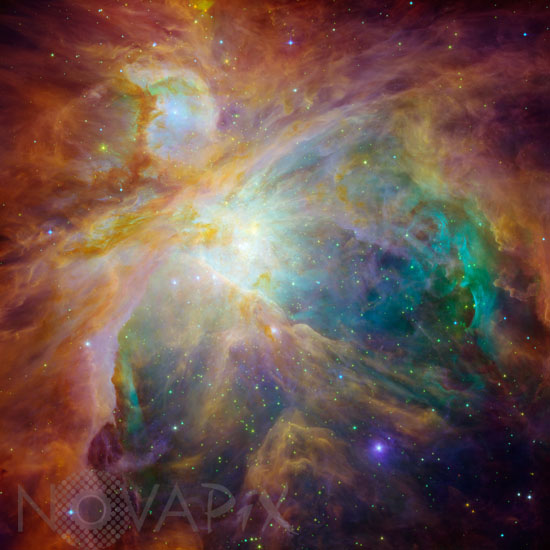Photo Agency - Astronomy - Space - Nature

Orion nebula composite
author: NASA/JPL-Caltech/Novapix
reference: a-neb19-76009
Image Size 300 DPI: 18 * 18 cm
This infrared and visible-light composite indicates that four monstrously massive stars at the center of the cloud may be the main culprits in the familiar Orion constellation. The stars are collectively called the "Trapezium." Their community can be identified as the yellow smudge near the center of the image. Swirls of green in Hubble's ultraviolet and visible-light view reveal hydrogen and sulfur gas that have been heated and ionized by intense ultraviolet radiation from the Trapezium's stars. Meanwhile, Spitzer's infrared view exposes carbon-rich molecules called polycyclic aromatic hydrocarbons in the cloud. These organic molecules have been illuminated by the Trapezium's stars, and are shown in the composite as wisps of red and orange. On Earth, polycyclic aromatic hydrocarbons are found on burnt toast and in automobile exhaust. Orange-yellow dots revealed by Spitzer are actually infant stars deeply embedded in a cocoon of dust and gas. Hubble showed less embedded stars as specks of green, and foreground stars as blue spots. Located 1,500 light-years away from Earth, the Orion Nebula is the brightest spot in the sword of the Orion, or the "Hunter" constellation. The cosmic cloud is also our closest massive star-formation factory, and astronomers believe it contains more than 1,000 young stars.
Keywords for this photo:
2004 - 2005 - 2006 - ASTRONOMY - COMPOSITE - DIFFUSE NEBULA - EMISSION NEBULA - FALSE COLOR - HST - HUBBLE SPACE TELESCOPE - INFRARED - M42 - M43 - MOLECULAR CLOUD - NEBULA - NGC 1976 - NGC 1982 - ORION - PAH - REFLECTION NEBULA - SPITZER SPACE TELESCOPE - STAR - TRAPEZIUM - YOUNG STAR -
Contact : Stéphane Aubin +33-(0)9-51-26-53-76
© Novapix - All rights reserved


